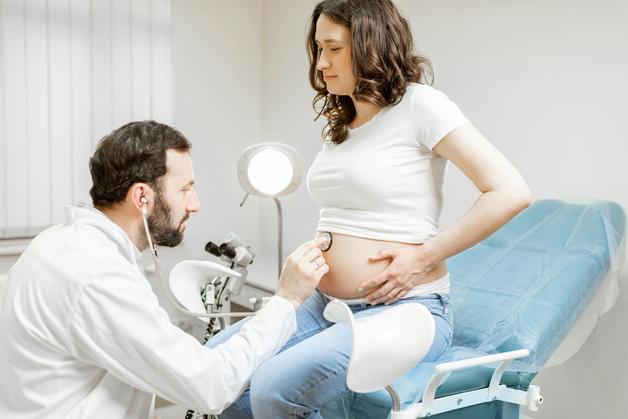The third trimester: excitement and anticipation, but also unexpected twinges and aches in places you’d never imagined. Rib pain during pregnancy—weighed down by the pressing, growing uterus—has a way of making itself the uninvited guest at a moment’s notice. You reach for the remote, only to feel a sharp, squeezing ache beneath your chest. Or perhaps it’s a slow-burning pressure, radiating around your side, leaving you to wonder: Why here, why now? Questions swirl: Is this normal? When should comfort tips suffice and when does it warrant a call to your provider? If rib pain during pregnancy dominates your thoughts—or simply nags at your daily routine—here’s what science reveals, what your body signals, and practical steps that make a genuine difference to your well-being.
Why rib pain during pregnancy happens: mechanical, hormonal, and baby-driven origins
Expecting parents often notice that rib pain during pregnancy emerges as a slow crescendo. Sometimes it whispers in the second trimester; sometimes it crashes in the third, when fetal growth and uterine size peak. The mechanical explanation is straightforward yet profound: the uterus, intent on finding space, ascends and exerts pressure on the rib cage. Suddenly, those exquisitely shaped ribs—meant for both stability and flexibility—complain under newfound tension.
But the causes don’t end there. Hormonal shifts, particularly soaring levels of relaxin, introduce ligament laxity. While relaxin’s true calling is to ready the pelvis for birth, its action isn’t so selective. Ligaments supporting the chest wall become supple, destabilizing the front of the rib cage—inviting discomfort, and at times, a deep, relentless ache.
Now, add another player: fetal kicks and stretches. There’s artistry in how a baby can wedge a little heel directly under your ribs or stretch with surprising force, triggering intense, fleeting pains or persistent rib discomfort. This can be especially pronounced on the right side, given the liver’s location and the natural sway of the expanding uterus.
You might wonder: Could it ever be something more concerning? Absolutely. When rib pain during pregnancy arrives with fever, significant swelling, difficulty breathing, high blood pressure, or changes in fetal movement, it’s a non-negotiable invitation for a thorough medical check-up—to exclude issues like preeclampsia or infection.
Decoding the triggers: posture, muscle strain, digestive twists
Not all rib pain during pregnancy flows from a single source. Often, it’s a symphony of influences—some medical, others environmental:
- Mechanical compression: It’s not just upward pressure. The rib cage itself, though beautifully adaptable, resists these changes at a cost—tightness, dull aching, intermittent stabbing sensations, amplified by certain fetal positions.
- Pregnancy hormones: The familiar culprit—relaxin—allows more pliability within the chest. Flexible ribs are better for delivery but often less comfortable for going about your daily life.
- Postural adaptation: The baby bump changes everything, even your stance. Shoulders roll, back arches, and suddenly, the ribs are drawn into new angles. Intercostal muscles—the slender bands running between your ribs—can tense and fatigue, resulting in burning or pinching pain, especially when switching positions or taking a deep breath.
- Digestive system challenges: Acid reflux and heartburn often ride along pregnancy’s course. After a meal, discomfort just beneath the ribs can spike, the upward push of gastric contents echoing in sharp upper abdominal sensations. Occasionally, the gallbladder—a small organ tucked under the liver—becomes sluggish, risking gallstones and an intense, right-sided pain that rises after fatty meals.
- Nerve involvement: Sometimes, it’s not simply the muscles or bones, but nerve compression—intercostal neuralgia—that’s at play, radiating pain toward the back or down along the chest wall.
When does rib pain during pregnancy make its entrance?
For most, rib pain during pregnancy tiptoes in as the uterus begins its upward climb through the second trimester—a transition marked not only by belly expansion but by subtle, daily shifts in how you sit, move, even breathe. By the third trimester, with baby’s limbs finding homes just beneath your ribs and the uterus at maximum volume, discomfort often peaks.
Rare in the first trimester, the likelihood intensifies as the weeks pass, making it one of the more common but puzzling complaints late in pregnancy.
Recognizing the many faces of rib pain during pregnancy: sharp, dull, radiating
If only all rib pain during pregnancy were the same. But symptoms have an endless variety:
- Intense, sharp stabs, brought on by a sudden stretch or artful fetal movement.
- Deep, dull aches, sitting in the background, perhaps exacerbated by certain postures, sitting for long stretches, or reaching upward.
- Radiating discomfort—pain that begins near the rib and tracks to the back, shoulder, or side, a signature for nerve compression or swelling.
Right-sided rib pain, shadowed by the liver, can signal either normal anatomic shifts or gallbladder stress. Occasionally, preeclampsia (a condition marked by high blood pressure and organ involvement) makes its debut as right upper abdominal pain—rare but worthy of respect. Meanwhile, left-sided pain often links directly to fetal position or muscular adaptation.
Red flags? Pain so strong it overshadows everything else, gets worse with breathing, refuses to ease with rest, or is joined by fever, swelling, shortness of breath, nausea, visual changes, or decreased fetal activity: a clear message to consult your care team.
What increases the risk and what makes it worse?
Every parent’s story with rib pain during pregnancy is unique, but certain themes repeat:
- Prolonged slouching or less-than-ideal posture amplifies pressure and strain on the rib cage.
- Lower baseline core or back muscle strength means less support as the abdominal wall stretches.
- Greater weight gain and fluid retention can invite additional swelling and discomfort.
- Fetal positioning—especially a little one camped out under the rib edge—intensifies and prolongs symptoms.
- Digestive issues, including heartburn and constipation, pile on, particularly after eating.
Seeking a diagnosis: careful conversation and medical evaluation
How do professionals approach rib pain during pregnancy? Attentive listening is the starting point: where does it hurt, when, how, and what brings relief (or aggravation)? A focused exam follows—checking posture, pressing gently on the ribs and muscles, and listening carefully to breathing and heartbeat.
Sometimes, it’s straightforward and immediately reassuring. At other times, specific measurements (like blood pressure to check for preeclampsia), ultrasound (to visualize baby, gallbladder, or liver), or blood tests (for liver enzymes or infection markers) are needed. Imaging atypically—like X-rays or CT scans—returns only if absolutely necessary, and always weighed against pregnancy safety.
The aim is clear: sort common, self-limited discomforts from anything requiring urgent attention.
Strategies to soothe rib pain during pregnancy: practical relief and self-care
What can be done when rib pain during pregnancy shows up daily? Plenty, often without resorting to medication. Here’s what medical evidence and real-world experience recommend:
- Gentle stretching: Raising one arm overhead and leaning to the opposite side stretches the spaces between the ribs and can help ease tightness.
- Diaphragmatic breathing: Placing your hands on your belly, breathing in deeply through your nose, and exhaling slowly—invites relaxation for both diaphragm and chest wall.
- Frequent changes in position: Long hours sitting? Take breaks. When resting, positioning a pillow beneath the knees can lower abdominal pressure.
- Pregnancy balls and movement: Gentle rocking or rolling on an exercise ball encourages spinal and pelvic mobility, soothing sore rib areas.
- Supportive tools: Belly bands or pregnancy belts help distribute weight and may relieve downward and outward pressure.
- Focused posture adjustment: Consciously sitting upright, avoiding slouching, and alternating sitting and standing positions supports the rib cage and diaphragm.
- Warm or cold packs: Applying gentle warmth (never directly to the belly) or a cool pack, for brief periods, may temporarily ease pain.
- Soft tissue massage: Targeted, gentle massage—especially along the intercostal muscles—can bring surprising relief.
- Clothing matters: Supportive, non-restrictive bras and loose clothing help avoid unnecessary rib cage compression.
- Nighttime positioning: Side-sleeping, with a body pillow tucked beneath the belly and between the knees, can dramatically ease night symptoms.
- Prenatal activity: Activities like walking, prenatal yoga, or swimming—promote flexibility and muscular support.
- Meal adjustments: Eating smaller, more frequent, high-fiber meals relieves digestive contributors like heartburn.
- Hydration: Ample fluids optimize digestion and circulation.
- Medication: If pain persists, acetaminophen (paracetamol) is generally considered safest, but only after confirmation from your care team. Medicines like anti-inflammatories should be avoided without direct advice.
- Alternative therapies: Osteopathy, chiropractic adjustments, and physical therapy—administered by experienced professionals—can target rib, diaphragm, and back tension, safely and effectively.
Professional therapies: when self-care meets expert support
Sometimes, at-home strategies aren’t enough. This is when osteopathic experts—utilizing subtle manipulation techniques—target the diaphragm, chest wall, and lower back to relieve rib pain during pregnancy. Chiropractors, using gentle realignment methods, focus on freeing joints and alleviating radiating pain, while physiotherapists guide posture, controlled breathing, and safe exercise to reinforce daily comfort.
Safety comes first: only consult professionals specialized in prenatal care, with credentials attesting to their expertise.
Medical approaches: when the pain persists
Some cases demand more: persistent or severe rib pain during pregnancy, or pain with concerning symptoms, should always prompt medical evaluation. Bacterial infections, preeclampsia, gallbladder attacks, or trauma are not to be dismissed—timely intervention, monitoring and, on occasion, hospitalization become necessary pathways. Pain management options are measured and closely supervised, always balancing benefit against safety for both parent and baby.
Above all: self-prescribing is strongly discouraged. Any medication or supplement requires medical validation—protecting you and your developing child.
Daily life: impact and solutions
Rib pain during pregnancy can upend daily routines: reaching, turning, sitting for long stretches—all can provoke or worsen discomfort. Adapting habits is key. Think posture: upright, well-supported sitting; breaks for stretching; body pillows at night; supportive clothing throughout the day.
Emotional well-being deserves equal airtime. It’s not just physical. Communicating openly with healthcare providers, partners, or friends, practicing relaxation techniques, and setting realistic expectations all foster resilience.
Associated challenges: not just the ribs
Rib pain during pregnancy rarely stands alone. It can be flanked by:
- Lower back pain, worsened by spinal curvature and muscular tension
- Sciatica, as nerve compression sends pain down the leg
- Pelvic discomfort, a pulling or heaviness in the lower body
- Digestive changes: bloating, heartburn, constipation that flare upper abdominal and rib discomfort
- Braxton-Hicks contractions—mild, tightening uterine sensations
- Preterm regular contractions should always prompt urgent review
Any pain that significantly limits activity, interrupts sleep, or partners with swelling, breathing difficulty, vaginal bleeding, or loss of fetal movements must trigger immediate professional evaluation.
Prevention and preparation: healthy habits for resilience
Preventing rib pain during pregnancy doesn’t require extraordinary measures, but it demands consistency:
- Early osteopathy check-ups, ideally by week 12—priming your chest and diaphragm for changes ahead
- Ergonomic adaptations for sitting, sleeping, and working—pillow props, alternating positions, movement breaks
- Gentle, regular stretching and diaphragmatic breathing to maintain flexibility
- Moderate exercise—walk, swim, join a prenatal yoga session—as permitted by your provider
- Diet discipline: smaller, fibrous meals, and consistent hydration
- Above all: never hesitate to consult when pain puzzles, lingers, or feels concerning
Each pregnancy writes its own narrative. Thoughtful, flexible support—paired with evidence-based care—lays the foundation for a more comfortable and empowering experience.
Key takeaways
- Rib pain during pregnancy is common, most often benign, and usually results from a mix of mechanical, hormonal, and postural influences.
- The condition can present as sharp, sudden stabs or subtle, persistent aches—often linked to growing uterine pressure, ligament softness, and baby’s movements.
- From gentle stretching and mindful posture to targeted physiotherapy or osteopathy, practical solutions abound for daily relief.
- When rib pain during pregnancy refuses to recede or presents with alarming symptoms, medical expertise is essential to ensure the safety of both parent and baby.
- Resources—and compassionate healthcare professionals—stand ready to support and guide you through discomfort. For tailored advice, in-depth questionnaires focused on you and your baby’s needs, and a wealth of practical health tips, explore the Heloa app for a reassuring, expert-led journey.
Your comfort, your confidence, your peace of mind: all matter, every step of the way.
Questions Parents Ask
Can rib pain in early pregnancy indicate something serious?
Rib pain is most often associated with the later stages of pregnancy, but it can sometimes appear in the first trimester. In the vast majority of cases, early rib discomfort is related to normal adaptations: your body is already beginning to change to create space for your growing baby. If the pain remains mild and passes quickly, il n’y a généralement pas de raison de s’inquiéter. However, if you notice severe, constant rib pain, or if it appears with symptoms such as fever, intense nausea, chest pain, or shortness of breath, it is important to reach out to your healthcare provider. These signs may suggest another cause requiring attention.
How can I tell if rib pain during pregnancy is coming from the baby or something else?
Rib pain can indeed stem from your baby’s movements, especially as space becomes limited and little feet sometimes find their way under your ribs. Often, this kind of discomfort feels abrupt or comes and goes, usually following a noticeable kick or stretch. However, rib pain may also be caused by posture changes, muscle strain, or digestive issues. If the pain is constant, getting worse regardless of movement, or spreads to other areas like your back or shoulders, il importe d’en discuter avec votre professionnel de santé pour en déterminer l’origine et recevoir des conseils adaptés.
Is it normal for rib pain to be felt on just one side?
Yes, it is quite common to feel rib pain more on one side than the other during pregnancy. The right side is frequently affected, as the growing uterus can push up under the right ribs, and the baby’s position often favours that area. In addition, organs like the liver are situated on the right, which can add to the sensation of fullness or pressure. If the pain is mild to moderate, varies with movement, and improves with rest or changing position, cela est généralement tout à fait normal. However, if the pain is sharp, severe, persistent, or accompanied by concerning symptoms (like swelling, difficulty breathing, or visual disturbances), don’t hesitate to consult for reassurance and support.









